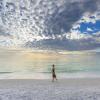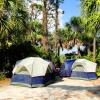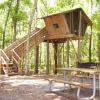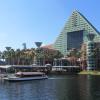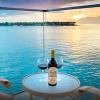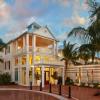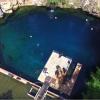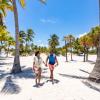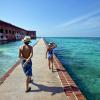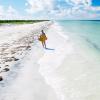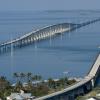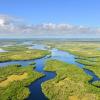By Laura Hampton
Part wildlife refuge and part time capsule, Fort Clinch State Park invites guests into a Florida long since gone — when the state was new, war was common and the smell of cotton lingered in the salt air.
Located on the northernmost point of Amelia Island, the fort was built strategically on the Cumberland Sound, a dividing line for Georgia and Florida. Here, the Amelia and St. Marys rivers meet before dumping into the Atlantic Ocean.
A Colorful Past
Construction on the two-toned fort began in 1847 with brown brick from the South. Florida had just become a state, and the federal government wanted to protect its important cities, specifically the natural deep-water port of Fernandina Beach, says David Roeser, an Amelia Island resident and park volunteer.
Labor was hard to find, though, so progress was slow in the first 20 years.
When war came in 1860, Confederate soldiers occupied the fort. The Union took possession of Fernandina Beach and the fort in March 1962, bringing engineers and much needed money to complete the fort. And along with those resources: red brick from the north.
“Of course, it’s not complete,” Roeser says. “But it’s as complete as it will ever get.”
Soldiers were stationed at the fort during the Civil War, the Spanish-American War and World War II, but no pitched battles were fought on the grounds.
“People are disappointed, sometimes, that there was no fighting here,” Roeser says.
He assures visitors longing for exciting battle stories that the soldiers did have skirmishes, and “they would shoot at each other.”
“Of course, they would also trade with each other. The federal soldiers had coffee, and the Confederate soldiers had tobacco.”
Though visitors won’t hear stories of rocket-glaring battles and history-defining strategic moments, they will get a glimpse of everyday life for the 200-plus soldiers who roamed these fortified walls during America’s early history.
At least once a month, Fort Clinch becomes a living history museum with male and female volunteers dressed in period costume demonstrating daily life at the fort. Along with Union soldiers, the volunteers also portray Confederate soldiers, and soldiers during the Spanish-American War, when the uniforms become decidedly more American.
“We’re wearing cowboy hats by then,” Roeser says.
Pristine Beauty
The park’s entrance and the fort are separated by a paved three-mile, Spanish moss-draped canopy road. In the 2,178 acres of maritime hammock, salt marshes and shore-lined dunes in between, deer roam, shore birds wade and turtles nest.
Hikers and bikers enjoy the scenic 5.1-mile in-and-out nature trail, but visitors can see plenty of flora and fauna on the paved roads and boardwalks that meander through the park.
Fort Clinch is a favorite for Florida resident Carol Hayden, who has spent one weekend a month for the last 20 years in a state park campground. Carol and her husband have been to Fort Clinch about five times.
He likes the history, and Carol likes the “awesome” surprises she finds at all the state parks.
On their first visit, the Haydens were sitting on the sand behind the fort when Carol caught a glimpse of something out of the corner of her eye.
“We both jumped,” Carol recalls. “It was a big submarine coming out of the base.”
Naval Submarine Base Kings Bay is 30 miles north near St. Marys, Georgia.
Simply Accessible
In a December 2020 spinalcord.com article, “Top 5 Accessible State Parks in Florida,” author Tiffiny Carlson ranked Fort Clinch No. 4. In addition to the fort’s rich history, Carlson sited wheelchair accessibility as a major reason for including it on the list. Accessibility features of note included boardwalks near the beach and all-terrain beach wheelchairs that are available on a first come, first served basis. The article also mentioned two fully accessible campsites as well as fully accessible bathrooms.
The park has two campgrounds, one on the Atlantic Ocean and one on the Amelia River. Most campsites are equipped with electricity and water, but there are six primitive tent sites. The Amelia River campgrounds also includes a wheelchair accessible fish cleaning station.
Handicap parking is available throughout the park — at the fort, at the beach, at the picnic table area, and at Egan’s Creek lookout.
Fort Clinch State Park is open 365 days a year. Entrance to the park is $6 per vehicle, and the fort entrance fee is $2.50 per person.
When You Go…
Fort Clinch State Park
2601 Atlantic Ave.
Fernandina Beach FL 32034
904-277-7274
Additional Accessible State Parks in Northeast Florida
Anastasia State Park, St. Augustine
Promises of endless summer draw thousands of visitors each year to the unspoiled shores of Anastasia State Park. With more than 1,600 acres of cinnamon beach, tidal marshes, maritime hammocks and ancient dunes, fun in the sun is the park’s main attraction.
“It’s so amazing to have miles of beach access without condos and homes — where wildlife and people can co-exist,” says St. Augustine resident Denise Rhodin. “It’s pretty special.”
Since undergoing major surgery this year, Rhodin is one of several regulars who use the park’s three all-terrain beach wheelchairs. She is unable to walk long distances and the recovery will take months, husband Scott Smithner says.
“The beach is actually the best therapy for her,” Smithner says. “But we wouldn’t have been able to do if the park didn’t provide those really neat wheelchairs.”
Purchased by Friends of Anastasia State Park, the wheelchairs are used daily, says Sam Basara, General Manager of the Island Beach Shop and Grill.
Water, Water Everywhere
Making the beach and other water activities accessible to all is a top priority at the park, Basara says. “We want everybody to have a good time.”
Mobi-mats provide access to the main beach as well as the kayak and canoe launch at Anastasia Watersports.
“We have paraplegic guests who come and sit in the front of a kayak and have somebody in the back paddle them,” Basara says.
Located on Salt Run, a 3-mile lagoon that borders Anastasia Island and Conch Island, Anastasia Watersports is the hub for many of the park’s rentals. In addition to kayak and canoe rentals, guests will find beach chairs and umbrellas here.
Fishing is at its best on the east bank of Salt Run. Trout is the main catch, but anglers also snag plenty of reds and flounder. Bait is available for purchase in the Island Beach Shop, and freshwater cleaning locations are near the main beach area.
Roughing It
The park’s campground contains 139 sites that can accommodate RV or tent camping. Each site is equipped with electricity and water, along with a picnic table, in-ground grill and fire ring. Currently, there are eight ADA accessible sites.
Camping supplies, including ice and firewood, are available at the Island Beach Shop. Golf Carts can also be rented here.
In the last few years, the park has worked to make access to the Old Spanish Quarries available to all. A hard-pack trail, about 200 yards from the parking lot, takes visitors to the coquina quarries.
A variation of limestone consisting of sand and mollusk shells, coquina was mined at the quarries in the early 17th century to build houses and other structures in the colonial town of St. Augustine, which is across the Matanzas River from Anastasia Island. The quarries were listed on the National Register of Historic Places in February 1972 since the coquina was used to build St. Augustine’s most iconic structure, the Castillo de San Marcos.
On-Site Shop and Restaurant
In addition to hiking trails, accessible picnic areas and miles of paved roads and sidewalks meandering through the park, the Island Beach Shop and Grill provides convenience for many campers and day trippers.
The shop carries camping supplies, beach toys, apparel and Anastasia Island keepsakes. The walk-up restaurant offers burgers, sandwiches, tacos and other snacks.
St. Augustine resident Debby Emerson says the on-site restaurant, easy parking and low cost of admission are a few of the reasons she chose this park for her mother’s beach day outing. A native of St. Charles, Missouri, 82-year-old Barbara Schoerer has not seen the ocean “in a very long time.”
Emerson made several failed attempts to take her mom to the beach. The first few times she tried, all the park’s beach wheelchairs were already checked out.
“It was very disappointing,” Emerson says. “She gets all dressed up … all excited … and then we can’t do anything.”
Then, Emerson discovered St. Johns County Beach Services. With three days’ notice, Beach Services will deliver a wheelchair to any of the county’s beaches at no charge.
“The whole process could not have been easier,” Emerson says. “They dropped it off, chained it to the bike rack and gave us the combination via email.”
Watching her mom play in the ocean has made the persistence worth it.
“She put her feet … her foot … in the ocean and I got a great picture of her smiling with the waves coming up on her. This whole thing has just been great!”
Live Music
Overflow music from the St. Augustine Amphitheatre is an unexpected amenity at Anastasia State Park, which sits directly behind the St. Augustine Amphitheater. The amphitheater hosts hundreds of concerts each year, so be sure to check the schedule before planning your trip. Some say it’s the best seat in the house. Don’t worry, though, the music stops at 10 p.m., so you won’t miss out on any sleep.
Saturday Market
Each Saturday, the St. Augustine Amphitheater hosts a farmer’s market, from 8:30 a.m. to 12:30 p.m., where dozens of local vendors sell fresh food, produce and handmade arts and crafts. The amphitheater is accessible from the park, and entry to the market is free.
World Class Shops, Restaurants and Attractions
Historic St. Augustine is a short 1.7-mile drive from Anastasia State Park. The “old town” features hundreds of one-of-a-kind shops and restaurants as wells dozens of tourist attractions including the Castillo de San Marcos, the Fountain of Youth Archaeological Park, the Lightner Museum and the St. Augustine Pirate & Treasure Museum.
Fort George Island Cultural State Park, Jacksonville
Fort George Island’s former inhabitants have left their footprints forever in the constantly shifting sands. Throughout the island’s rich history, Timucuans, pirates, Spanish priests, plantation owners, African slaves and 1920s-era socialites have worked and played in the coastal marshes.
Biking and hiking are popular ways to explore the island’s breathtaking views, but a 23-marker audio virtual ranger tour is available for a self-guided driving tour. Visitors can stop by the Ribault Club and find out how to access the MP3 tour, which walks guests through the 4.4-mile Saturiwa Trail on the island and points out areas of ecological and historical significance.
Fishing and bird watching are two favorite pastimes in the island’s coastal salt marshes. Anglers at Fort George Inlet report snagging spotted seatrout, red drum and black drum most commonly. Bird watchers report seeing migratory songbirds, nesting Indigo and Painted Buntings as well as tri-colored heron, white ibis, clapper rail, wood storks and swallow-tailed kites.
Built as a swanky club for wealthy northern tourists in 1928, the Ribault Club is currently used for weddings and other events. Visitors can tour the grand building, however, and relive the opulence of the past as well as visit the permanent historical display that provides a timeline of the island’s rich history.
Also located on Fort George Island, Kingsley Plantation offers visitors a glimpse into life on a Southern plantation in the 18th century. Operated by the National Park Service, visitors can explore the plantation grounds, which include the owner’s house, built in 1798, and the oyster-shell tabby concrete slave quarters as well as the kitchen house, waterfront property and interpretive gardens.
Big Talbot Island State Park and Little Talbot Island State Park, Jacksonville
Regarded locally as “the real Florida,” the Talbot Islands state parks technically includes seven parks: Little Talbot Island, Big Talbot Island, Amelia Island, Fort George Island, Pumpkin Hill Creek Preserve, Yellow Bluff Fort and George Crady Bridge Fishing Pier.
As a whole, however, the Talbot Islands invite visitors to explore dynamic coastal habitats in their natural state. Kayaking, fishing, camping, birding, picnicking, shelling and sunbathing are popular pastimes, as are hiking, biking and horseback riding.
One of a few undeveloped barrier islands in Florida, Little Talbot Island features five miles of white sand beach and 36 campsites. Each campsite is equipped with electricity, fresh water, a fire ring and picnic table. The campground also has a laundry facility and two bath houses, both of which are ADA accessible. Beach wheelchairs are available on a first come first served basis. The park also includes a wheelchair-friendly 2.5-mile paved Timucuan Trail where visitors will find a covered bike pavilion, benches and interpretive displays.
A popular picnic spot, Big Talbot Island is best known for the picturesque Boneyard Beach. In addition to picnic facilities with tables, grills and ADA accessible restrooms, the park features an elevated viewing platform deck at the bluffs with mobi-mat to improve accessibility. In addition, paved sections of the Timucuan Trail run through the park and allow access to the boardwalk to Spoonbill Pond.
Bonus
Part of the 3,000-mile East Coast Greenway, parts of the Timucuan Trail run through Big Talbot and Little Talbot Islands. In this area, the trail is mostly off-road paved pathway. It runs north 6 miles to Peters Point Beach Park and south crossing the A1A bridge to Big Talbot Island State Park. The southern section takes visitors across the mouth of the Nassau Sound to a wooden boardwalk overlooking Spoonbill Pond, a premier birding spot in Northeast Florida.
Ravine Gardens State Park, Palatka
Spring begins in December at Ravine Gardens State Park when the vibrant colored azaleas burst through the 152-acre property.
The park owes it splendor to the vision of local contractor Thomas Byrd and landscape architect Richard Forester, but also to FDR.
A Roosevelt Obelisk at the park’s entrance pays homage to Franklin D. Roosevelt and his Works Progress Administration for creating the only New Deal-era park in Florida with a formal designed landscape.
The park officially opened in July 1933, but it took four years for Civil Conservation Corps workers to plant 95,000 azaleas and more than 250,000 ornamental plants in addition to building roads and other structures. Today, 14 varieties of azaleas blanket the park in shades ranging from white to flaming red (and every color of pink and purple in between) from December through March.
A 1.8-mile paved loop around the park’s parameter includes several wheelchair accessible overlooks that offer views into the ravine. The loop also runs by an accessible paracourse fitness area as well as the old amphitheater where the first Florida Azalea Festival Beauty Pageant was held in 1938 with 10 contestants.
Eventually, the Florida Azalea Festival outgrew the park and is currently held on downtown Palatka’s waterfront.
An accessible picnic pavilion is in the spot where the Old Concession Building once stood. The concession building provided refreshments for baseball fans in the 1940s when Ravine Gardens hosted the Azalea Bowl, and baseball legend Babe Ruth taught the minor league Palatka Azaleas a few tricks. Rumor has it, he hit six straight homeruns into the ravines.
The park is listed on the National Register of Historic Places and is a National Landmark for Outstanding Landscape Architecture.
Washington Oaks Gardens State Park, Palm Coast
The former home of RCA founder Owen D. Young and his wife, Louise Powis Clark Young, the park’s immaculately maintained grounds require exploration.
Located 2½ miles south of Marineland on coastal road A1A, the 400-acre property stretches from the Intracoastal Waterway to the Atlantic Ocean and contains maritime hammocks, scrub and beach dune habitats.
The most impressive terrain on the property, however, is Mrs. Young’s intact formal gardens.
“She gave the property to the State on the condition that we maintain her garden for perpetuity,” says Amber Hamilton-Smith, Park Services Specialist at Washington Oaks.
The ornamental gardens provide year-round color with azaleas, camellias, orchids and citrus as well as an English-style rose garden. Trails through the garden are hard-packed crushed coquina, which makes them wheelchair accessible.
A paved road runs through the property, separating the gardens and homestead from the gift shop, which was Mr. Young’s former office and produce stand. The three-room log cabin once housed a dark room for photography, a living space and a porch where Mr. Young washed citrus and other farm produce. He sold the produce from a stand on the corner of old A1A, the paved road that now runs through Washington Oaks.
“Mrs. Young was worried about her husband having to cross A1A to get to the gift shop where he sold citrus,” Hamilton-Smith says. “The Young family had a lot of power back in the day, so they petitioned the state to have A1A moved.”
Listed on the National Register of Historic Places in 2009, the property includes the Youngs' cottage, a restored greenhouse and the gift shop, which is run by some of the park’s 200-plus volunteers.
The cottage serves as a museum showcasing a historic representation of the Youngs’ living room and interpretative signs that tell the history of the region and the property. The signs are equipped with phones for audio translation for the visually impaired.
Across the new A1A, beach access is included in park admission. Restoration efforts are still underway after two hurricanes — Matthew in 2016 and Irma in 2017 — wiped away the dunes.
“The water was up to the ranger station,” Hamilton-Smith says.
The hurricanes destroyed a boardwalk that provided passage over the dunes to the beach. In its place, a permanent mobi-mat runs from the parking lot to the Atlantic Ocean.
In addition to beach access, fishing is a popular pastime on the banks of the Intracoastal Waterway, and a half dozen picnic tables are available near a children’s playground area.
Washington Oaks Park is open 365 days a year. Gift shop hours are 11 a.m. to 3 p.m. Friday–Sunday.
Gamble Rogers Recreation Area, Flagler Beach
A small park with a big legacy, Gamble Rogers Recreation Area honors the memory of the folk artist musician whose tales of the fictional Oklawaha County closely resembled real-life characters in his native Winter Park, Florida.
A frequent camper at Flagler Beach, Rogers died in October 1991 trying to save a drowning man from the rough surf near what was then called the Flagler Beach State Recreation Area.
In 1992, the Florida Legislature passed a bill to rename the park in honor of Roger’s heroic effort. A small memorial in the ranger station tells Rogers’ story and pays tribute to his life and music.
A popular camping spot for beach lovers, the intimate 150-acre park is noted for its two camping grounds – one on the river and one on the beach that provide 68 camping sites.
Popular activities include swimming, beachcombing, fishing and kayaking. Recently, the park added a handicap accessible kayak launch. In addition, beach wheelchairs are available on a first come first served basis and a boardwalk over the dunes provides access to the beach.
The park also has a large picnic area with ADA accessible picnic tables and benches.
As an added bonus, the campgrounds is a 5-minute drive to Flagler Beach, a quintessential “Old Florida” beach town with locally owned shops and restaurants as well as an art gallery, museum and beachfront winery.
